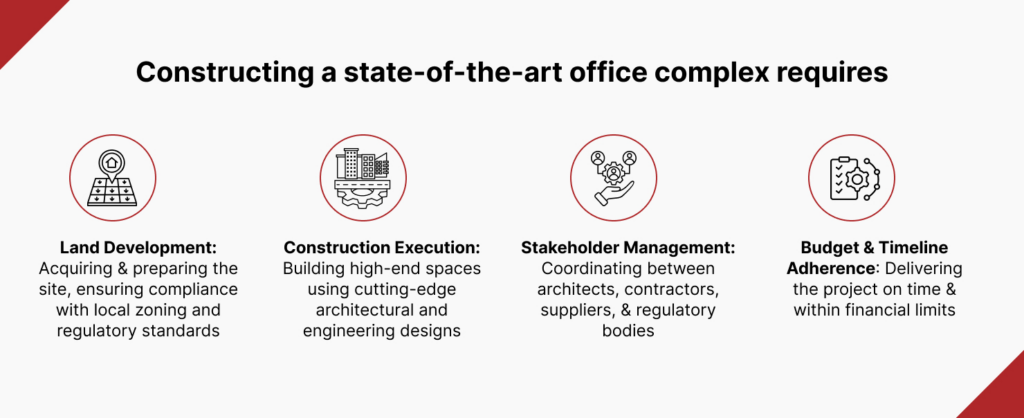
High-stake commercial real estate projects demand meticulous planning, prompt execution, and a skilled workforce prepared to tackle complexities head-on. When budgets are tight, deadlines are non-negotiable, and reputations hang in the balance, the margin for error is razor-thin.
What are the possibilities of success of a project when high-risk decisions like using some junior employees result in budget overruns and missed deadlines?
Ronald Mayers, the Chief Learning and Development Officer (CLDO) at a commercial real estate company in Florida, got into such a situation. Let us learn how he uses a custom simulation to prepare his employees with a learning-by-doing approach.
The Project at Stake: A Commercial Real Estate Opportunity
With decades of experience in the industry, Ronald had built a reputation for enhancing workforce performance and driving the success of high-stake real estate projects. Ronald’s company, one of the leading and most reputed commercial real estate companies in the US, secured a highly lucrative and critical project, one that had the potential to unlock a series of future opportunities if executed successfully.

The success of this project depended on meeting stringent quality, design, and compliance standards.
As the CLDO, Ronald carried the critical responsibility of ensuring the workforce was equipped with the skills and readiness to execute such a big project.
He was responsible for developing training programs to prepare employees, particularly juniors, to tackle domain-specific challenges, allocating tasks based on the team’s capacity and expertise, managing internal and client expectations through regular progress updates, and intervening during crises to address skill gaps and inefficiencies during the execution.
Ronald was responsible for developing training programs to prepare employees, allocating tasks based on the team’s capacity and expertise, managing internal and client expectations through regular progress updates, and intervening during crises to address skill gaps and inefficiencies.
Despite his efforts, his decision to rely on junior employees for the most part, while cost-effective, had serious drawbacks.
When his team needed to procure high-end materials for the construction phase, they depended on a junior employee to source and order supplies. The employee misunderstood the instructions in the project’s inventory tracking system and assumed key materials had not been ordered. Without verifying with the procurement team, they placed a second order for the same items. The procurement team also had not conveyed on time that the products had been purchased.
The error was discovered only when the duplicate materials arrived. The order was placed at the last moment with a no-return policy. As a result, the team got stuck with excess stock that added more burden to the already overrun budget!
The error was discovered only when the duplicate materials arrived. The order was placed at the last moment with a no-return policy. As a result, the team got stuck with excess stock that added more burden to the already overrun budget!
This wrong step left the company with no choice but to spend the budget for upcoming unexpected costs instead of hiring extra manpower to finish the job on time. This misstep threw the project even further behind schedule.

It was devastating for Ronald and his company alike when the client expressed frustration over missed milestones and subpar execution, making potential future contracts difficult.
This whole incident demotivated the workforce, leading to immense stress and burnout for many in the team but mostly on Ronald, who had to face mounting pressure from the senior management to justify his decisions and explore corrective measures.
The incident demotivated the workforce, leading to immense stress and burnout for many but mostly on Ronald, who had to face mounting pressure from the senior management to justify his decisions and explore corrective measures.
A reactive approach wouldn’t suffice in this situation. Ronald needed proactive measures to close skill gaps, rebuild confidence and prepare all employees to tackle future projects with the right methods and tools.
How leveraging Simulated Powered Learning helped Ronald and his team manage projects effectively
As Ronald explored options on the internet, he came across Simulation Powered Learning (SPL) and learnt about custom, immersive training simulations that reflect your company’s unique business context, so employees can learn-by-doing—preparing them for the real-world challenges of executing complex projects in just three months.
Ronald was quick to reach out to the SPL team. Ronald and his management team decided to implement the SPL platform for their upcoming projects.

Let’s learn about the features of SPL and how it benefitted Ronald and his team.
- Custom Project Management Training Simulation: By embedding the company’s unique processes, real-world challenges, and project complexities into the simulation, SPL provided a highly contextualized training program baked into the business’s needs. Ronald’s team learned by executing a simulated version of the high-stakes office complex project, gaining hands-on experience without real-world risks. They practiced resource allocation, decision-making, and stakeholder management, improving their ability to handle future projects.
- Industry-Specific Expertise Baked Into the Simulation: The simulation incorporated Ronald’s company’s specific challenges, such as tight budgets and regulatory compliance, making the training highly relevant. Employees gained contextual knowledge of the company’s workflows and project nuances, ensuring they could make informed, confident decisions during project execution.
- Ability to Configure the Simulation to Align with Changing Business Strategy: As the company’s strategy evolved, Ronald was able to adjust the training modules to stay relevant, ensuring workforce alignment with business goals. This adaptability prepared the team to tackle new challenges, fostering agility in a competitive industry.
- Interactive, Learn-by-Doing Experience to Engage Employees: The engaging and immersive format motivated employees, helping them retain knowledge and skills longer than traditional training methods. It boosted morale and reduced stress by offering a risk-free environment to practice high-stakes tasks.
- Single Simulation Score to Measure Training Effectiveness: Ronald could track employee progress through measurable scores, identifying skill gaps and readiness levels to ensure every team member was project-ready. The clear metrics allowed Ronald to demonstrate the training’s ROI and its impact on workforce efficiency to senior management.
Through the implementation of Simulation Powered Learning (SPL), Ronald Mayers successfully turned a critical workforce challenge into an opportunity for transformation and excellence.
The implementation of Simulation Powered Learning (SPL) successfully turned a critical workforce challenge into an opportunity for transformation and excellence.
Revolutionizing Training with Immersive Simulated Learning
Unlike traditional, lecture-based training methods or static online content, SPL provided immersive simulated learning that was far more engaging, experiential, and effective. By incorporating the company’s unique business processes, roles, and challenges, SPL’s custom simulation tailored to the company’s business context ensured that employees gained the skills and confidence needed to execute real-world projects seamlessly.
Moreover, SPL offered a single simulation score to measure training effectiveness, allowing Ronald to track employee readiness and identify skill gaps. With a proven track record of building custom simulations for major enterprises and the ability to deliver rapid deployment within just three months, SPL offered Ronald’s company a fast and cost-effective solution. The inclusion of a Train the Trainer Program empowered the internal team to sustain and scale training efforts long-term.
Train your employees using an immersive, real-world experience tailored to your company within your company’s business context just like Ronald did!
Powered by MarketEngine from StartupWind